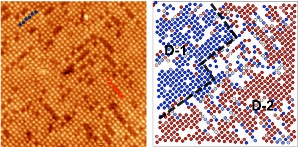A novel combination of microscopy and data processing has given researchers at the Department of Energy’s Oak Ridge National Laboratory an unprecedented look at the surface of a material known for its unusual physical and electrochemical properties.
 An Oak Ridge National Laboratory study combined microscopy and data processing to provide an unprecedented look at the surface of a magnanite material known for its unusual properties. The resulting “distortion maps” (right) brought into view structural areas called domains that were not easily identified in the raw images (left).
An Oak Ridge National Laboratory study combined microscopy and data processing to provide an unprecedented look at the surface of a magnanite material known for its unusual properties. The resulting “distortion maps” (right) brought into view structural areas called domains that were not easily identified in the raw images (left).
The research team led by ORNL’s Zheng Gai examined how oxygen affects the surface of a perovskite manganite, a complex material that exhibits dramatic magnetic and electronic behavior. The new avenue to understand surface behavior could benefit researchers who are interested in using a wide range of correlated oxide materials for applications such as solid fuel cells or oxygen sensors.
“Surface properties are key for any sensitive application, because the surface controls the interaction with the outside world,” said coauthor Art Baddorf.
The team’s results, published in Nature Communications, underscore why the materials are called “strongly correlated:” Because the chemical and physical functionalities are coupled, any minor change can influence the entire system.
“It’s like the material has many knobs, and if you turn one, all the properties change,” Gai said. “You turn a different knob and the whole thing changes again. It turns out the surface is another knob -- you can use it to change the properties.”
The researchers used high-resolution scanning tunneling microscopy to generate images of the manganite surface -- down to the level of 30 picometers. A picometer is one trillionth of a meter. They then processed the imaging data to determine the position of each atom and calculate the angles between the atoms.
“Knowing where the atoms are positioned shows how they are interacting,” Baddorf said.
The resulting “distortion maps” brought into view structural areas called domains that were not easily identified in the raw images. The maps clearly showed how the presence of oxygen atoms forced the atoms into a checkerboard pattern known as a Jahn-Teller distortion. Gai says the team’s study is the first time the phenomenon has been observed on a material’s surface.
“The oxygen totally changes the surface energy,” Gai said. “Once you introduce oxygen, the electrons don’t like to form a straight line; they zigzag to get to a lower energy state. This distortion is a very common concept in bulk materials, but nobody has been able to show this effect on the surface before.”
The study is published as “Chemically induced Jahn–Teller ordering on manganite surfaces.” Coauthors are ORNL’s Wenzhi Lin, Paul Snijders, Thomas Ward, J. Shen, Stephen Jesse, Sergei Kalinin, and Arthur Baddorf; University of Nebraska’s J.D. Burton and Evgeny Tsymbal; and IHI Corporation’s K. Fuchigami.
This research was conducted in part at the Center for Nanophase Materials Sciences, a DOE Office of Science user facility. The DOE’s Office of Science supported the research. Work at the University of Nebraska-Lincoln was supported by the National Science Foundation.
UT-Battelle manages ORNL for the Department of Energy's Office of Science. The Office of Science is the single largest supporter of basic research in the physical sciences in the United States, and is working to address some of the most pressing challenges of our time. For more information, please visit http://science.energy.gov/.